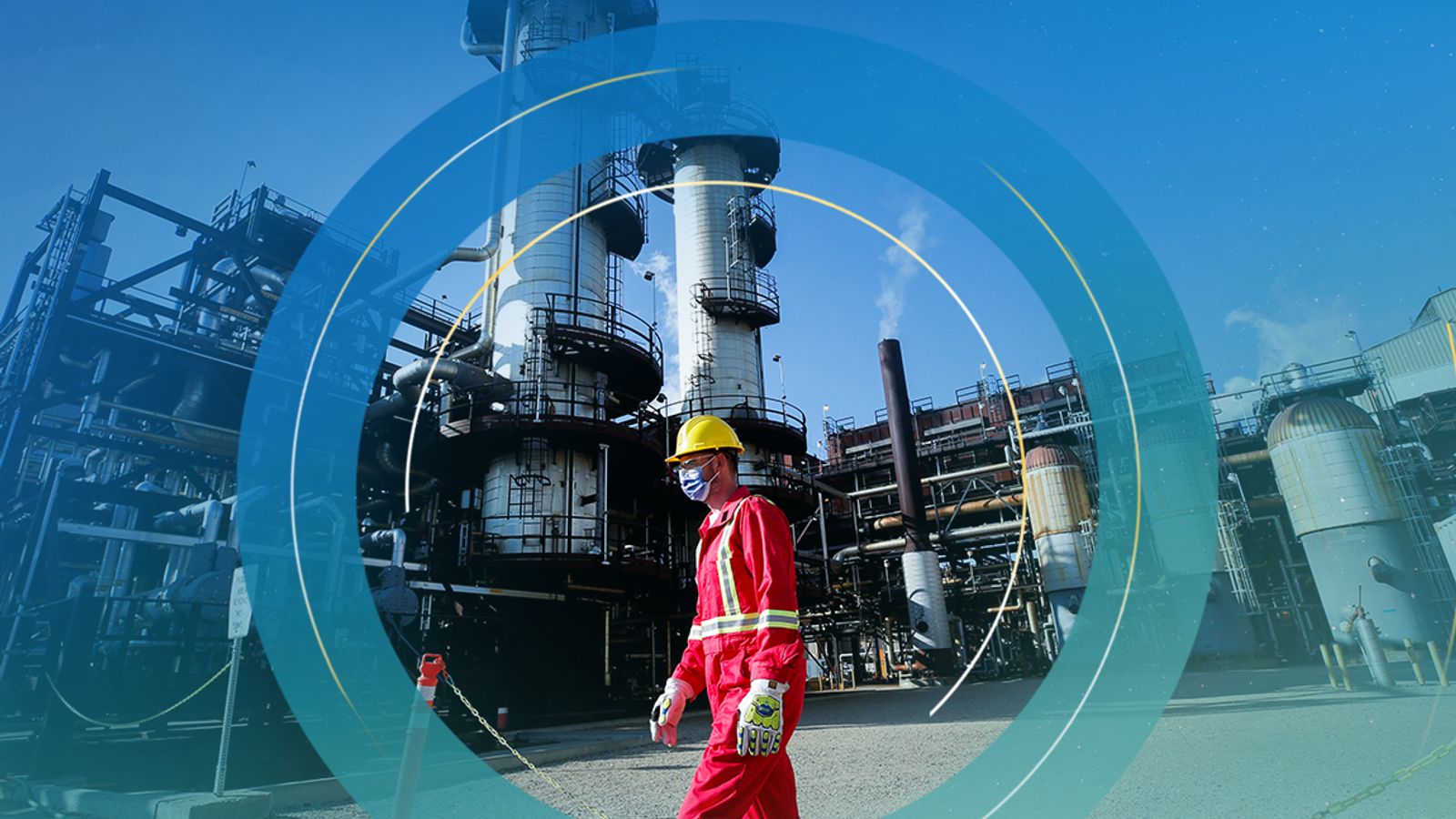On a rainy, windswept day a couple of weeks ago, I stood on the Aberdeenshire coast and laid my hand on the main pipeline bringing natural gas into this country.
Britain was in the early throes of the energy crisis which is still reverberating at the time of writing; motorists were queueing at petrol stations; a series of power companies had collapsed amid astonishingly high gas prices.
Yet here, beneath my hand, somewhere between 10% and 20% of this country’s natural gas was passing noiselessly within the thick steel walls of this pipe.
Installations like the gas terminal at St Fergus are part of the infrastructure without which this country would grind to a halt. Fortified by barbed wire, patrolled by military guards, ringed by chimneys whose roaring gas flares light the twilight sky, sites like these seem like a vision of Britain’s 20th century past, not its green, renewable future.
Yet even as Britain burns more gas and coal than it has done for years, old fossil fuel sites such as this one are quietly plotting to reinvent themselves as the saviours of the climate.
As this country attempts to eliminate greenhouse gas emissions and get to the much-vaunted “net zero” target by 2050, places like St Fergus are promising, tantalisingly, to get Britain over the line.
If the idea of dirty gas terminals helping save the planet sounds odd – perverse, even – then consider the maths.
COP26: US senator blocking Joe Biden’s climate legislation poses threat to success of climate summit
COP26 organisers reject claims climate summit ‘mismanaged’ and run by ‘inexperienced’ staff
Climate change: ‘Your future depends on the future of the planet,’ Prince Charles warns children in documentary
Right now Britain emits just over 500 megatonnes of greenhouse gases – carbon dioxide or equivalent. By 2050 this needs to be down at zero.
It’s possible to imagine replacing much of our power generation with renewable sources of power, wind turbines and solar. It’s possible we might replace our internal combustion engine cars with electric, we might fly a bit less and eat a bit less meat.
But even if everything went to plan, even if everything went about as well as it could, we would still be left with a stubborn 100 megatonnes or so of emissions from everything from farting cows to steel manufacture to cement production to chemicals processes to the gas fired power stations we occasionally need to fire up when the wind isn’t blowing hard, such as was happening when I laid my hand on that gas pipeline.
Now, in a decade or two we might have brilliant synthetic meat to replace much of our beef. We might, in the longer-run, find a way of producing truly green steel or making cement without CO2 emissions or, for that matter, solar panels without coking coal (yes, really), but no one expects that in time for 2050.
So unless we are to eschew the trappings of 21st, or for that matter 20th, century life, we need to find a way of dealing with that final, stubborn 100 megatonnes.
When you strip away all the hyperbole this is the real issue at the heart of net zero. It is possible, with the technology we have at our disposal, to envisage the elimination of the majority our emissions. But getting those emissions down to net zero and dealing with those final 100 megatonnes… that is the real challenge.
Which brings us back to the St Fergus gas terminal and those pipes coming in from the North Sea.
A hundred yards or so alongside the one bringing methane from British and Norwegian oil and gas fields in towards the grid is another big pipeline which, these days, is empty.
This blue slightly-rusted pipe, which disappears into the ground and then dives down under the sea, used to carry in gas from the Goldeneye field about a hundred kilometres offshore. But it might, just might, help solve the problem of those final 100 megatonnes.
The institution responsible for mapping out how Britain could plausibly get its emissions down to net zero is the Climate Change Committee (CCC).
A group of economists, climate scientists and engineers, their job is to come up with carbon budgets and hold the government to account for whether it is or isn’t on track to meet those goals. In recent years, the CCC has produced a series of dense reports on how this transition might actually work.
The problem with attempting to plot such courses is that they are fraught with unknowns.
Will people really be willing or able to change their behaviour enough? Will technology advances come in as expected or hoped for? Will government interventions help or hinder the process? So instead of drawing up a single road-map to net zero the CCC has come up with a host of scenarios.
Some of these scenarios are optimistic, some are more cautious. Some demand more government intervention, some presume household behaviour changes do more of the heavy lifting (so, we insulate our homes more or consume less meat). But there is one thing these scenarios nearly all have in common.
They assume, in short, that Britain will need some technological assistance to eliminate those final 100 megatonnes and get the country over the net-zero line.
Some of that assistance will come in the form of changes in land use: more land given over to forests, clever soil techniques used to sequester carbon. But, most important of all, they rely on something called carbon capture and storage (CCS).
The concept behind CCS, as it is usually called, is actually far simpler than you might have assumed.
At present you have lots of fossil fuel power stations, chemicals plants, steelworks, cement kilns and so on which are emitting carbon out of their chimneys and into the air. The idea behind CCS is to take those fumes, remove the carbon dioxide and either find a use for it or, more likely, store it under the ground.
This is the plan with those pipes at St Fergus. According to Nick Cooper, chief executive of Storegga, a company devoted to CCS, the idea is to reverse what the gas terminal does.
“What you’ll see is a carbon capture storage facility, sending the CO2 captured from this gas offshore, to make the gas effectively carbon zero. And in addition, piggy-backing on all of that will be the manufacture of hydrogen, which of course is a net zero fuel.”
The proposed project at St Fergus, the Acorn scheme, is one of a number of planned hubs around the UK, each of which promises to do something similar: to provide a place where heavy industry can co-locate, pooling their carbon emissions which are then captured and sent under the ground.
There are plans, too, to remove carbon directly from the air (direct air carbon capture, as it’s known) as well as from these pipes where it is concentrated, though this is even more prototypic at present.
In theory this all makes plenty of sense. Net zero is not the same thing as zero emissions – the clue is in the “net”. So negative emissions technologies like carbon capture and smarter land use policies could help offset the continued emissions from elsewhere. Purists may baulk at this but it is mathematical and practical.
And in theory the UK is among the best-placed countries in the world to do it.
This nation has some of the world’s biggest depleted oil and gas fields, not to mention the expertise in working offshore. These constitute some of the most important ingredients to become Europe’s preferred dumping ground for carbon dioxide.
And there is nothing, at least from a technological standpoint, to prevent this from happening.
We have been removing certain chemicals from industrial fumes for the best part of a century. Doing so costs money and makes industrial processes less efficient (since you need to expend some energy on carbon removal as well as, say, generating power or making cement) but it is, in theory, very much doable.
And, given climate change ultimately comes down to a surfeit of carbon dioxide in the atmosphere, there is a certain clarity and simplicity to CCS: if there’s too much carbon in the air then why not just take it straight out of the air? In some respects it sounds too good to be true.
Raising a question: is it? Because the important phrase you’ll have noticed repeatedly above is “in theory”. For while carbon capture technology is older than solar panels, it has yet to be used at scale anywhere in the world.
There is no shortage of pilot projects: there is one in Norway, a few in Canada; there is a shipping container-sized unit at the Drax Power Station in North Yorkshire which I visited a few years ago. But important and pioneering as they are, these schemes are, when you consider the scale of the carbon reduction challenge facing this country let alone this planet, piddling.
Between 1990 and 2020, across the world these schemes captured 139 megatonnes of carbon. This is not trivial in the slightest. But here’s the rub: in the following three decades the International Energy Agency, which does similar sums as the CCC for the world rather than just the UK, expects these schemes to capture some 7,740 megatonnes.
It is not merely that this is a big increase, though at 5,468% it certainly is that. It is that we have never achieved a technological leap at anything like this rate before.
In a research paper published earlier this year, two Cambridge University academics, Sarah Nelson and Julian Allwood, examined historical energy transitions, everything from the adoption of coal and gas to nuclear power.
They found that there was simply no historical precedent for the kinds of numbers expected of carbon capture schemes. “Our evidence suggests that policymakers who continue to rely on technology transitions to reduce emissions will be unable to deliver climate targets by 2050,” they wrote.
These are the numbers and assumptions that undergird both the UK and global plans to eliminate carbon emissions. Not merely ambitious; unprecedented.
To have any confidence in them you would expect to see some sign that policymakers here and elsewhere were deeply committed to carbon capture. Yet most of the evidence from UK experience over the past decade or so goes in completely the opposite direction.
Over the past weeks I have toured the country, looking at prospective carbon capture sites and also at the sites which, not all that long ago, were supposed to represent the future of carbon capture. For it turns out the country is littered with CCS graveyards, much-hyped projects that never met expectations and were quietly canned.
I visited Longannet in Fife, a coal-fired power station which was once cast as the bright future for CCS. There were plans to remove all the carbon from the chimneys and store it elsewhere. But after a long pilot scheme the operators concluded that it was simply too expensive. In 2011 the scheme was cancelled altogether.
Subscribe to ClimateCast on Spotify, Apple Podcasts, or Spreaker
I went to Peterhead power station where an analogous scheme met its end in 2015. That year, George Osborne decided that there was no point in putting a billion pounds into a set of CCS projects that could, if commissioned, have been storing away our emissions as you read this.
Carbon capture is, it transpires, the technology which has for decades promised to help eliminate carbon emissions and has for decades failed to deliver. So its tantalising position at the very heart of this and other governments’ plans to get to net zero is arguably the most controversial, most consequential and least-discussed issue at the heart of the climate debate.
Climate activists do not like carbon capture because they argue it gives fossil fuel companies an excuse to carry on burning fossil fuels. They argue, with some justification, that it may reduce the pressure on both governments and business to usher in a more profound energy transition, where the economy does not rely, one way or another, on legacy fuels.
Yet it is hard, impossible perhaps, to imagine getting to 2050 without either making extraordinary sacrifices – no flying, no meat, no concrete – or without a helping hand from carbon capture or something like it.
According to Simon Roddy, senior vice-president for UK Upstream from Shell: “It’s really important to stress that even at net zero, we will continue to need – and industry will continue to use – oil and gas. And CCS is a technology that actually helps us reduce the emissions from those industries that still require oil and gas.”
However the problem – for the oil majors and policymakers depending on it, not to mention the taxpayers who may end up funding it – is not merely that carbon capture is untested at scale; it is that even in those pilot schemes that have gone ahead, all has not gone to plan.
A lesson from the Sahara and the promise of hydrogen
Two thousand miles due south of the St Fergus gas terminal, in the sweltering depths of the Sahara desert, you will find the In Salah gas field. This project, run by the Algerian state oil and gas company alongside BP and Equinor, has been producing gas for nearly two decades, but it is worth pondering for another reason. This was one of the pioneering pilot schemes for carbon capture and storage.
When the gas comes out of the ground here it does so alongside impurities including carbon dioxide. That CO2 needs to be removed before the gas is used, so the project aimed to capture that CO2 and put it back underneath the sandstone formation from where the gas originally came.
What relevance does In Salah have for the UK’s efforts in this field? Well, back when the scheme began, some of the engineers involved said that the geology under the ground there was “very similar to that of the North Sea”.
For a few years in the 2000s the project seemed to be going to plan; carbon was being successfully removed from the gas coming from the ground and nearly four megatonnes was pumped back into the depleted fields. But then the geologists noticed something odd: the land sitting above the gas reservoir was starting to rise.
The change in the land surface was not discernible to the naked eye: it was an increase of barely two centimetres. Yet it was impossible to ignore what the sensors were telling them. The earth above where the CO2 was injected was rising. More to the point, this was not supposed to happen.
Please use Chrome browser for a more accessible video player
The expectation, before the project began, was that the CO2 would sit neatly inside the underground reservoirs which had held the oil and gas for hundreds of millions of years. But this didn’t seem to be happening. The CO2 was behaving unexpectedly.
Those working in carbon capture insist that the experiences at In Salah, or indeed at Gorgon, an Australian carbon capture and storage project with mixed results, are simply the kind of teething problems you’d naturally expect with a new technology. Yet they are part of the explanation for why the CCS roll-out has failed to proceed as quickly as had been expected.
The other part of the explanation comes back to something more prosaic: a persistent lack of government support. The reality is that carbon capture is expensive, and that there is little prospect, in the short or medium term, of expecting cement manufacturers or steelmakers to shoulder its cost without two things happening.
The first is hefty government support so businesses can afford it. The second is the need to put a price on carbon, either through a tax or a market to trade it. Either way, until government creates the necessary incentives, businesses are unlikely to dive in.
As Tom Baxter, senior lecturer in chemical engineering at the University of Aberdeen, puts it: “Until we get to the point where there is a case for deploying carbon capture from a commercial viewpoint, it will not happen. Unless… the government is prepared to give some very healthy subsidies to it.”
For Chris Stark of the CCC, the case for intervention is similarly straightforward: “I think it can be done, but it does rely ultimately on the government putting some big policies in place some of them are quite expensive. And for me that’s the bit that’s missing at the moment.”
This week the Department for Business, Energy and Industrial Strategy is due to lay out its plans for how we get to net zero. These are widely expected to entail more support for carbon capture. The idea is that with this strategy in place, projects like the Acorn scheme at the St Fergus gas terminal can finally begin.
The UK’s CCS hubs will begin construction and, within a few years what was previously a set of pilot schemes will become real, scale projects. In due course, the UK could become the world leader in this new, crucial technology.
The race could also bring with it new opportunities for the sector. There are exciting start-ups engaged in the quest. I met the co-founders of Carbon Clean, a company which has developed a more efficient system for capturing the carbon. Their units have a unique solvent and a unique way of sloshing the carbon emissions around to maximise the amount they can extract.
And it’s not merely the net zero targets depending on this all working out. A large part of Britain’s environmental and energy strategy, such as it is, is hinged on the promising new hydrogen economy.
Hydrogen is, depending on who you talk to, the ideal energy source of the future or a ginormous white elephant. Its advocates point to it as a superior way of storing energy to batteries. Hydrogen is an energy dense fuel that can be stored in fuel cells.
It can be used in industrial processes instead of methane; it can power heavy trucks which cannot run on batteries; it can go into boilers and heat homes around the country. Best of all, the only waste product when it’s burnt is water.
One problem with hydrogen, however, is that making it without emitting carbon is very difficult. Truly green hydrogen involves a set of electrolysis techniques which are incredibly energy intensive (raising the question, where does the power come from?).
The alternative is something called blue hydrogen, where hydrogen is created from natural gas, but this process generates copious carbon emissions which in turn need to be captured and put them back under the ground. In the energy transition, many roads eventually lead back to CCS.
You are perhaps starting to sense why what happens to these pipes matters so much. The environment depends on it, but so too does the economy. They promise to make net zero achievable, and to unleash a blizzard of investment.
But there are still nagging questions: if the technology is so good, why is it taking so long?
If governments are really committed to this, why have they been so hesitant to put their money where their mouth is? Is this real or simply yet more hype? Perhaps, after many false starts, we are about to find out.
Watch the Daily Climate Show at 6.30pm Monday to Friday on Sky News, the Sky News website and app, on YouTube and Twitter.
The show investigates how global warming is changing our landscape and highlights solutions to the crisis.






















